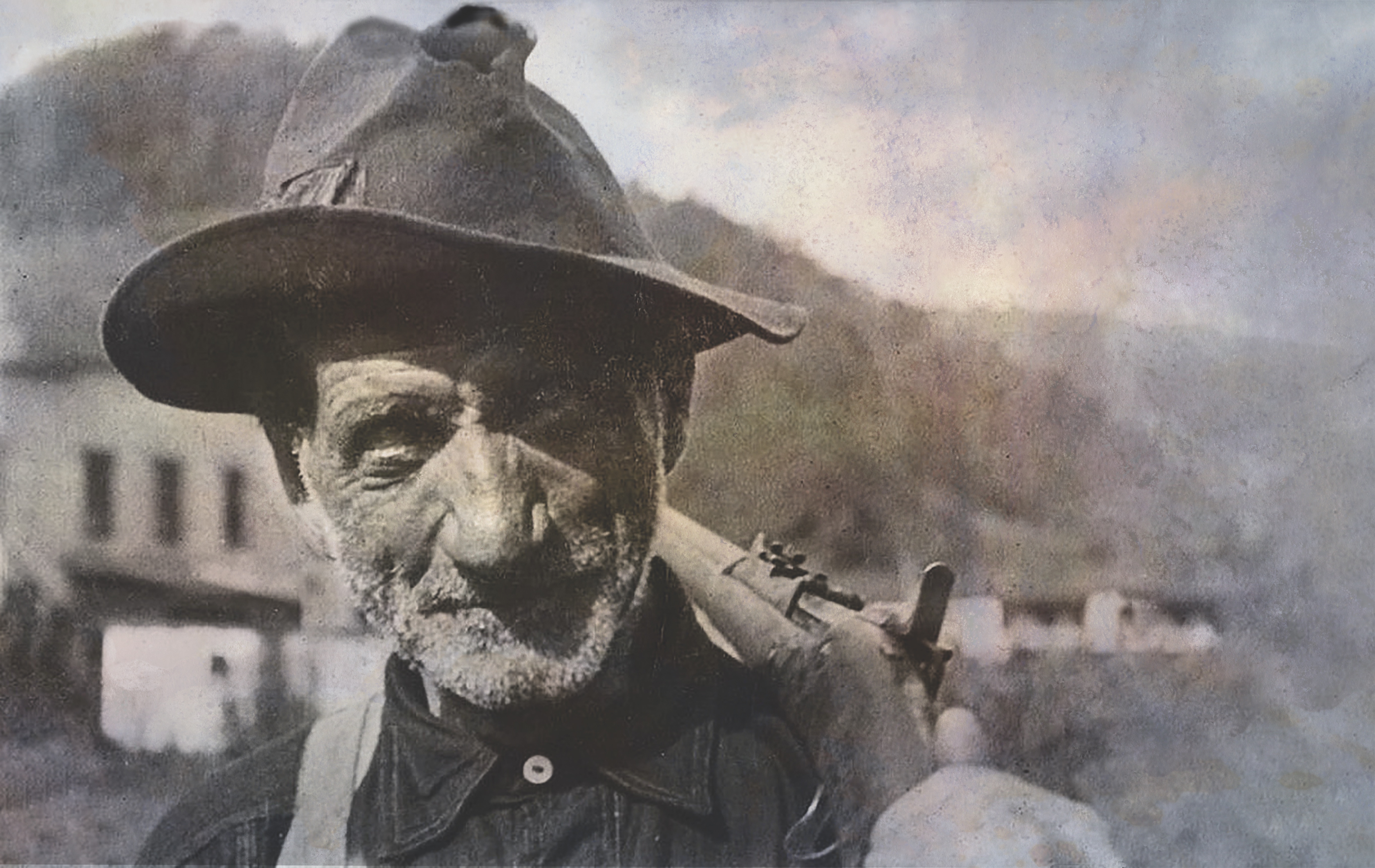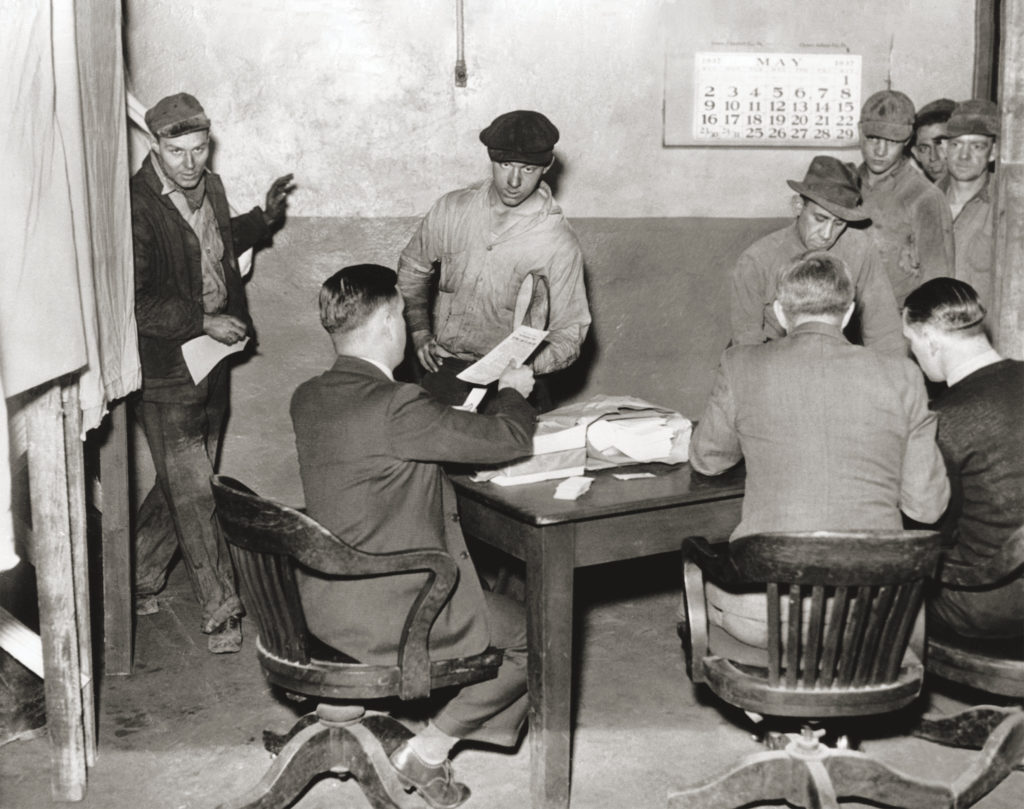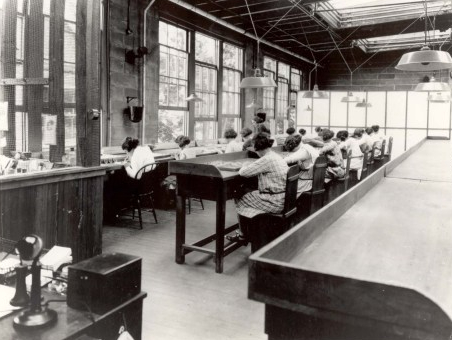On the night of August 30, 1921, the Reverend John Wilburn, a self-proclaimed Baptist minister in Blair, West Virginia, wasn’t tending to the Lord’s business. In defiance of an order issued by President Warren G. Harding, Wilburn was leading a party of 75 armed miners, some wearing tattered uniforms from the late war and bright red bandannas around their necks, up the east side of 1,800-foot-high Blair Mountain. Their mission was to feel out the defenses of the coal operators, sheriff’s deputies, and mine guards who had occupied the heights a few days earlier. The reverend instructed his troops in terms that were less than pacific. “Take no prisoners,” he said.
The next morning, after bivouacking for the night on a ridge halfway up the mountain, the miners were awakened by scattered gunfire. Leading a four-man scouting party, Wilburn came across three men blocking the narrow road around the ridge. Logan County sheriff’s deputy John Gore, armed with two pistols and a rifle, motioned for Wilburn’s men to come forward. Two nonunion miners, John Colfago and Jim Munsie, stood behind him, cradling rifles.
Recommended for you
An uneasy moment passed. Then one of the nonunion miners made a sudden move, and gunfire erupted. Gore, mortally wounded, managed to get off a shot as he fell to the ground. Eli Kemp, a black miner in Wilburn’s group, was struck in the back as he turned to run and also fell to the ground. Wilburn’s men crept forward through the gun smoke. Gore and Colfago were dead; Munsie writhed in agony in the tall grass. As Munsie begged for his life, union miner Henry Kitchin put the muzzle of his rifle against the wounded man’s forehead and pulled the trigger. Muncie’s head bounced off the ground, blood pumping out “like water out of a hose where you turn it on and the pressure is light,” one of the other miners observed. Wilburn’s men carried the unconscious Kemp back down the mountain to Blair, where he soon died in a doctor’s office.
With that brief, confused exchange of gunfire, the Battle of Blair Mountain—the largest armed uprising in the United States since the Civil War and the largest labor uprising in American history—commenced. For the next four days it would rivet the nation, as striking miners faced off against state police, hastily organized militia, and paid strikebreakers. Thousands of rounds from machine guns, rifles, shotguns, pistols—even improvised bombs dropped from private airplanes—would riddle the remote West Virginia countryside, and soldiers from three crack U.S. Army infantry regiments would rush to the front. Even the nation’s best-known military air commander, World War I hero Billy Mitchell, stood ready and eager to enter the fray.
The events that led to the bloody confrontation on Blair Mountain had begun more than three decades earlier, when representatives of the newly formed Norfolk and Western Railroad Company, cash in hand, swooped down on southern West Virginia’s sleepy hills and “hollers.” Bankrolled by wealthy investors from New York, Pennsylvania, Massachusetts, and Ohio, and even as far away as Great Britain, they quickly acquired huge tracts of land, legally or otherwise, as well as the mineral rights to what lay beneath. Some 5,000 workers soon began laying railroad track, building bridges, and drilling tunnels. The absentee land owners called the area “the El Dorado of Appalachia.”
Soon the locals, rugged descendants of Scots-Irish immigrants who had been working their farms for generations, abandoned their plows for work in the coal mines—and the regular paychecks that went with it. Most left their homes to live in newly built company towns, where migrant southern blacks and European immigrants joined them. The years that followed saw the implementation of a system of calculated subjugation. Life in the company towns was harsh, with discipline maintained by private detective agencies the owners employed. The most prominent of these was the Baldwin-Felts Detective Agency, whose operatives—“gun thugs,” the miners called them—included bounty hunters and convicted felons.
The coal companies controlled the police, along with everything else: churches, schools, stores, and the houses (often one-room shanties) in which the families lived. Miners’ wives had to buy food and other overpriced necessities at a company store, using “scrip”—devalued company currency—instead of cash. Having to buy their own equipment, miners started out in debt. With living costs often exceeding wages, they were driven further into debt with each paycheck. And in a business in which mules were valued more than men and the only way in or out of town was on a company train or a company road, the West Virginia miners and their debt-ridden families had nowhere else to go. They were prisoners, literally and figuratively, of the coal companies that employed them.
Men were paid about 40 cents a ton for the coal they mined—considerably less than the wages union workers earned in other states. And in the absence of federal regulation or inspection, the ton weight was adjusted up to 2,500 pounds. The miners bitterly referred to it as the “long ton.” Mining was a perilous occupation, made all the more so by the lack of safety regulations. On December 6, 1907, the worst mining disaster in American history occurred when an explosion in the Fairmont Coal Company’s two mines in Monongah, West Virginia, left 362 miners dead. No one was prosecuted, and the operators continued to block all attempts by state lawmakers to enact safety legislation.
By the early 1900s, the United Mine Workers of America had organized miners in Illinois, Indiana, Ohio, and Pennsylvania. The notable exception was West Virginia. There, nearly all the mines were nonunion, the repressive mine-guard system was in full operation, and anyone who joined or spoke in favor of the union was fired, evicted, and blacklisted from working at any other mine.
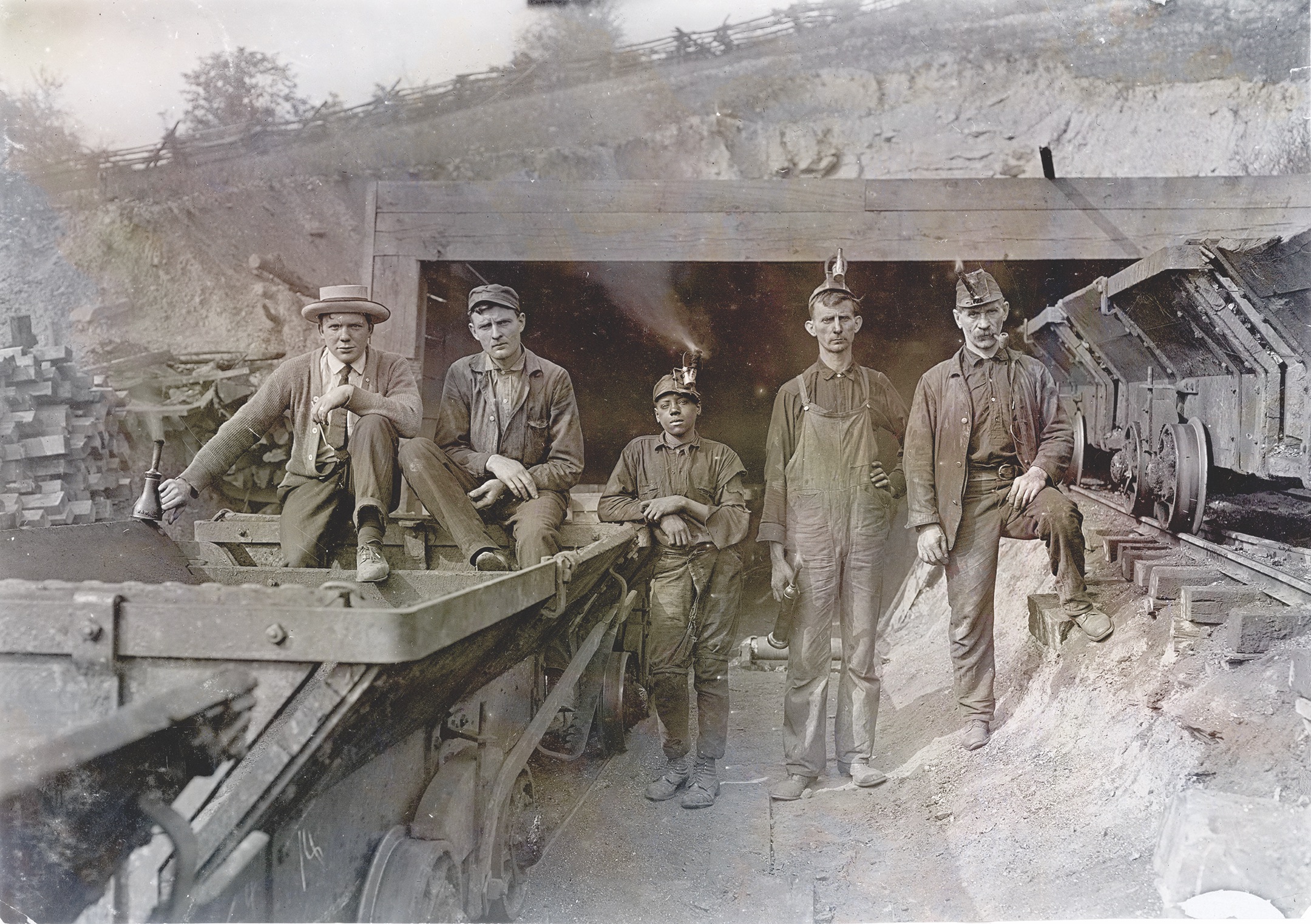
As West Virginia became a major coal producer, the UMW sought to organize miners in the southern part of the state. From the beginning, union organizers and recruiters were brutally and sometimes fatally discouraged from establishing a presence in the state. In 1901, a white-haired, bespectacled woman of 64 came to West Virginia at the request of the UMW president to preach the gospel of union. Mary Harris Jones, known to the miners as “Mother Jones,” was a charismatic speaker and an iron-tough, fearless advocate for working-class men and women. She spoke a salty language her audiences could readily understand, once lambasting West Virginia governor William E. Glasscock, for example, as a “goddamned dirty coward.”
In May 1902, the UMW called for a strike in the coalfields of eastern Pennsylvania, and a majority of West Virginia’s miners walked out in solidarity. Many were fired, and Baldwin-Felts detectives evicted thousands of families, forcing them to live in shacks and tent camps. Meanwhile, the financially strapped union, having depleted its meager resources in Pennsylvania, withdrew its much-needed support of the miners in West Virginia.
By 1912, fewer than 10 percent of West Virginia’s miners had unionized. That April, after the coal companies refused to grant even a small raise, Fred Mooney inspired some 3,000 of his fellow union miners at Paint Creek to strike. They demanded elimination of the long ton and the mine-guard system, an end to mandatory patronage of the company store, cessation of blacklisting practices, adoption of a nine-hour work day, and recognition of the union. The mostly nonunion miners of nearby Cabin Creek joined the Paint Creek strikers. The movement was both biracial and multicultural; the miners came from a wide range of backgrounds—blacks who had come from the South, white descendants of original West Virginia settlers, and immigrants from a wide array of European countries. The strikers were led by Frank Keeney, a charismatic miner whose family had lost its farm to a coal company years earlier.
The owners responded by hiring scabs and strikebreakers and firing and evicting Keeney, Mooney, and thousands of miners. Tent colonies again sprang up. Keeney appealed to the UMW for help but was refused. He then assumed leadership of the strike. Another 5,000 miners joined the walkout. When the operators sent hundreds of Baldwin-Felts thugs to break the strike, the miners fought back, blowing up trains, tracks, and coal tipples (machines that tipped over freight cars to unload them). Both sides were heavily armed, and shootings became commonplace. Raids and sniper attacks increased, and the death toll climbed. Some victims were left where they fell with a note pinned to their bodies that read, “Gone to hell, more to follow.”
Late on the night of February 2, 1913, Quinn Morton, the president of the Paint Creek Operators’ Association, commandeered an armored train and boarded it with the local sheriff, his deputies, and a contingent of Baldwin-Felts agents. In one car was a Gatling gun that could fire up to 400 rounds per minute. As the train passed the Holly Grove tent camp on Paint Creek, Morton’s men opened fire. Dozens of miners were wounded, but miraculously, only one was killed. Miners dubbed the train the “Death Special.”
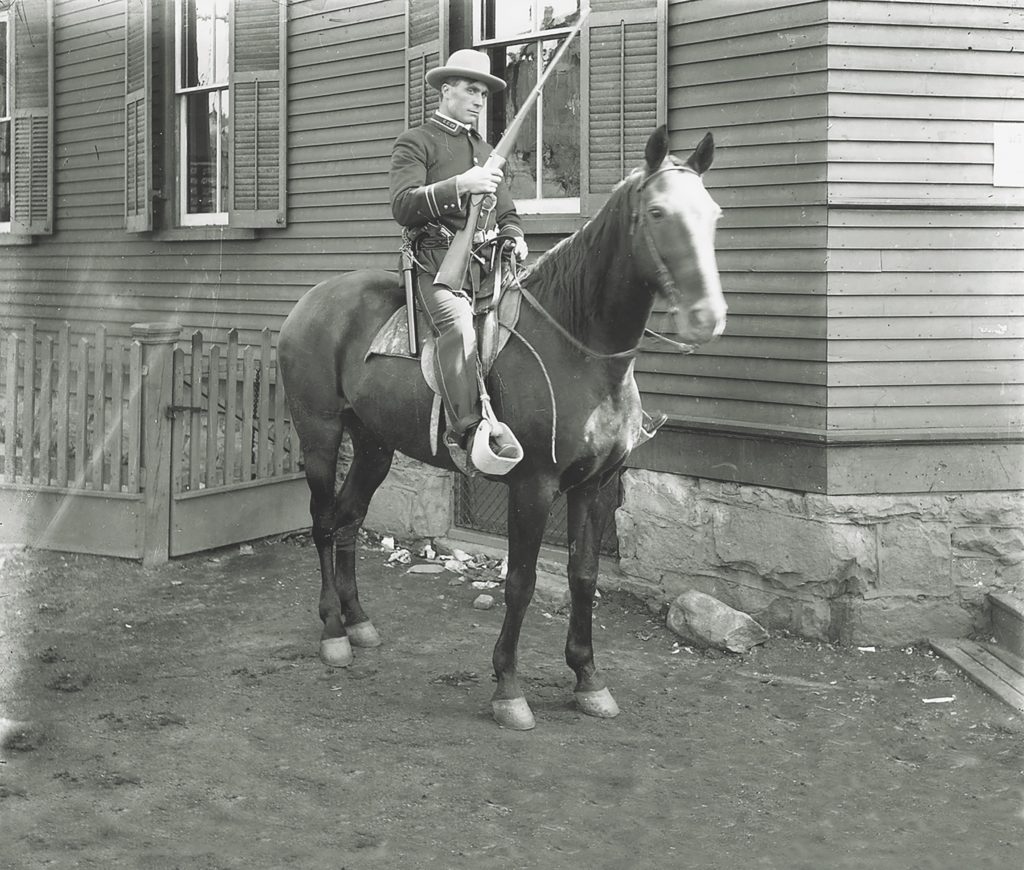
Later that week miners raided a guard camp, killing one man, whereupon Glasscock, due to leave office in a month, declared martial law and sent state troops into the region. In April, newly sworn governor H. D. Hatfield submitted an owner-friendly contract, which the exhausted Paint Creek strikers grudgingly accepted. The Cabin Creek miners held out until late July, when a more acceptable agreement was hammered out. Pressured by sympathetic lawmakers, Hatfield freed the convicted strikers. As many as 100 miners had died—some by bullets, others by starvation and disease—during the 15-month strike. Property losses were in the millions of dollars. The union’s victory, though small, still represented progress to the miners.
In 1913 Mother Jones returned to West Virginia at the behest of union organizer Frank Keeney, whom she had mentored as a young man. At the head of 3,000 armed miners, she led a march to the capitol in Charleston, where she thundered, “I warn this little governor that unless he rids Paint Creek and Cabin Creek of these goddamn Baldwin-Felts mine-guard thugs there is going to be one hell of a lot of bloodletting in these hills!”
The United States’ entry into World War I in 1917 brought an uneasy peace to West Virginia’s coalfields, as both miners and coal operators worked toward victory, providing huge quantities of coal, the nation’s main energy source. Frank Keeney, now the president of the UMW’s local District 17, and Fred Mooney, its secretary-treasurer, actively encouraged the war effort. Union membership grew significantly as soaring production ensured decent paychecks for the workers.
But after the war, the struggle resumed with a vengeance. Production dropped, and so did miners’ pay. Faced with escalating costs, coal operators ignored union demands and sought to reassert their prewar hegemony. Miners fought to hold on to what they had. In Logan County, some 5,000 miners conducted an armed march in solidarity with national strikes. Keeney and Mooney disbanded the march, however, after the new governor, John J. Cornwell, assured them that he would look into their grievances. Cornwell did not keep his word.
The following year, with the blessing of UMW national president John L. Lewis, Keeney set about unionizing the mines in coal-rich Mingo County. Coming from the nation’s most famous and powerful labor leader, Lewis’s support did much to legitimize the strikers’ cause. Keeney established his headquarters in Matewan, the county seat and one of the few pro-union towns, and soon some 3,000 of Mingo’s 4,000 miners had signed up. The operators responded by barring union men from their mines and forcing the remaining workers to sign “yellow-dog” contracts in which they pledged never to join the UMW. The stage was set for a series of events that would lead to an all-out shooting war between labor and management.
The war’s opening salvo was fired on May 19, 1920. That day Tom Felts, the head of the Baldwin-Felts Detective Agency, sent his brothers Lee and Albert to Matewan along with 12 other agents to evict union miners and their families from their homes. While walking to the Matewan train station after finishing their heartless work, the detectives were met by pro-union mayor Cabell Testerman and William Sidney Hatfield, his popular young police chief. “Smilin’ Sid,” as Hatfield was known, had earned a widespread reputation as a fist fighter and gunslinger, and that day he wore two heavy-caliber pistols on his belt. Anticipating (or perhaps planning for) violence, he had stationed striking miners at the windows of several buildings overlooking Mate Street. Meanwhile, Testerman had deputized more than a dozen “sober-minded” citizens to back them up.
GET HISTORY’S GREATEST TALES—RIGHT IN YOUR INBOX
Subscribe to our Historynet Now! newsletter for the best of the past, delivered every Wednesday.
Hatfield and the Felts brothers served each other with conflicting arrest warrants. Testerman flatly declared the Felts’s warrant “bogus,” and after a brief argument shots rang out from a number of positions. (Most eyewitnesses felt that Lee Felts had fired first, shooting Testerman in the stomach.) When the firing was over seven Baldwin-Felts men lay dead, including both Felts brothers on the scene. Three townspeople were also killed, among them Testerman, and four others were wounded. Word of the “Matewan Massacre” spread rapidly, and the beleaguered miners hailed Sid Hatfield as their new champion.
UMW membership soared to 95 percent. A jubilant Keeney offered to meet with the county’s 71 coal operators. When they refused, he called a strike. On July 1, thousands walked off the job. Predictably, the owners fired the strikers, evicted their families, and brought in strikebreakers and scabs. Matters would come to a head the following year, after a Mingo County jury found Hatfield and 22 codefendants not guilty of murder in the Matewan shootout.
The miners’ exhilaration over their courtroom victory was short lived. The mine owners still controlled the state government. Voters had recently elected the stolidly promanagement Ephraim Morgan as their new governor, and one of his first acts was to double the size of the state police force and place it at the disposal of the mine operators. On the one-year anniversary of the Matewan shootout, Morgan declared martial law, to be enforced by the state police and a newly formed vigilance committee of armed professionals—bankers, lawyers, doctors, salesmen, shop owners, farmers, real estate brokers—who harbored no sympathy for the miners. He dispatched the troops to Mingo.
Ignoring the miners’ constitutional rights, Morgan’s men arbitrarily arrested them for “conspiracy,” “bunching” (talking in groups of three or more), or simply looking suspicious. The situation rapidly grew worse, as men on both sides sniped at each other, often with deadly results. On June 14, some 70 state troopers, aided by the vigilance committee, raided the striking miners’ tent camp on Lick Creek, beating residents, destroying furniture, spoiling food supplies, and shredding tents. They shot and killed one unarmed miner and jailed 47 others without formal charges, cramming them into a single cell in chains.
On the morning of August 1, 1921, Sid Hatfield and his best friend and deputy Ed Chambers climbed the stone steps of the McDowell County Courthouse to face charges for allegedly blowing up a coal tipple in Mohawk the previous year. Their wives were with them and neither man was armed. At the top of the steps, three Baldwin-Felts detectives opened fire without warning at point-blank range, instantly killing Hatfield and Chambers. One of the murderers, ignoring Mrs. Chambers’s anguished pleas, fired a final round behind her husband’s ear for good measure. Another detective shot several times at the courthouse walls to give the impression the victims had fired first, then placed the smoking pistols in the dead men’s hands.
The national response to the murders was almost universally hostile to the miners and their union. The striking miners were painted as a gun-toting, moonshine-swilling threat to economic stability. This bias was reflected in the nation’s major newspapers. The New York Times, for example, referred to Sid Hatfield as a “primitive mountaineer” who had died as he had lived, pistol in hand. Many news accounts drew comparisons to the previous century’s infamous Hatfield-McCoy feud. (Sid, who had been unofficially adopted by a Hatfield, was only indirectly related to the clan.) Rarely did the miners’ side appear in print.
At the trial, a pro-owner jury ignored the testimony of multiple eyewitnesses and acquitted all the participants in the assassination. This infuriated the miners, hundreds of whom were still languishing in the Mingo County jail. Keeney tried to negotiate with Governor Morgan to avert further violence, but the governor refused to consider his suggestions. For the miners, this was the last straw.
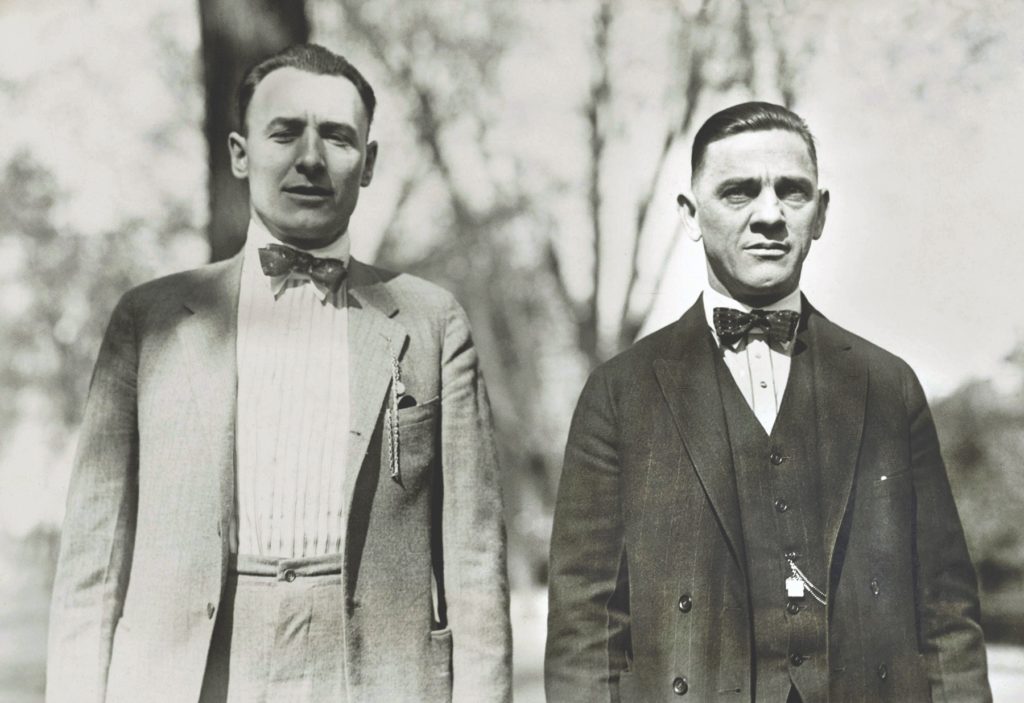
On August 20, some 700 armed miners camped near Charleston in preparation for a 50-mile march through Boone and Logan Counties to Mingo, where they planned to free their brother miners by force if necessary. By the 24th their number had swelled to nearly 10,000, with more coming in daily from all across the state. Union locals raised money for provisions, guns, and ammunition. Keeney and Mooney, while outwardly condemning the march, secretly encouraged it. “The only way you can get your rights is with a high-powered rifle,” Keeney told one gathering.
When he received word of the impending march, Logan County sheriff Don Chafin swore that no armed mob would cross the county line. Dubbed the “Czar of Logan County,” Chafin had long been on the mine owners’ payroll. (Despite an annual salary of $3,500, his net worth in 1921 was $350,000.) He assembled a 3,000-man army of deputies, strikebreakers, and a large middle-class vigilance committee like the one in Mingo County. Chafin armed his troops with rifles and machine guns seized from local hardware stores and the county arsenal. The sympathetic governor of Kentucky, Edwin P. Morrow, provided two additional machine guns, 400 rifles, 40,000 rounds of ammunition, and three World War I biplanes. The anti-union forces wore white armbands to differentiate them from the marching coal miners they loathed and feared.
Chafin’s men set to work erecting barriers and digging trenches, establishing a 12-mile perimeter in the gaps along Spruce Fork Ridge, on the border between Logan and Boone counties. Most of the miners would come from the northeast, but others would march up from Raleigh County in the southeast, and Chafin prepared to stop them from both directions. He concentrated the largest group of defenders at the gap that ran between the two 1,800-foot peaks defining Blair Mountain. Chafin’s riflemen occupied the high ground, and machine-gun emplacements covered the road on which the miners would have to pass.
An alarmed Governor Morgan repeatedly appealed to President Harding and Secretary of War John W. Weeks for 1,000 troops and a fleet of warplanes to stop what the New York Times dismissively described as a “mob of malcontents.” On August 26, Harding dispatched Brigadier General Harry H. Bandholtz, a highly decorated and competent career army officer, to West Virginia with orders to send the miners home. Bandholtz met with Keeney and Mooney and ordered them to call off the march. He gave them two days to comply. Otherwise, he warned, the army would “snuff them out” or arrest them for treason.
That same day, Brigadier General William “Billy” Mitchell, the aviation pioneer and nationally revered war hero, landed a squadron of three bombers near Charleston. Mitchell had ruffled many feathers in the military establishment and on Capitol Hill with his constant demands to upgrade the nation’s Air Service, as the fledgling U.S. Air Force was then called. He staged numerous exhibitions in which his fliers bombed old battleships, submarines, and destroyers to demonstrate the effectiveness of American air power. Now, as the commander of the First Provisional Air Brigade, he was eager to demonstrate the effectiveness of airplanes against disturbers of the peace—in this case the region’s striking coal miners. “All this could be left to the air service,” he told reporters at Kanawha Field outside Charleston. “If I get orders I can move in the necessary forces in three hours.” Asked how he would combat the miners on the ground, Mitchell responded: “We’d drop tear gas all over the place. If they refused to disperse then we’d open up, with artillery preparation and everything.”
Mitchell was talking about bombing American citizens.
Keeney and Mooney, sobered by the force mustering against them, advised the marchers to return to their homes. With warrants out for their arrest, the two leaders fled the state. That left Bill Blizzard, a union organizer who had assumed control of the march, in charge of disbanding the miners, even though Mooney considered Blizzard “all fire and dynamite, hot headed and irresponsible.” Still, as thousands of miners turned toward home, it seemed that bloodshed might be averted. But Chafin deliberately chose that moment to send 300 troops and deputies to the village of Clothier, 10 miles northeast of Logan, to arrest 40 participants in an earlier altercation, and in the process they killed two of them. “It was like pouring gasoline on the warm ashes of a campfire,” one of the miners later recalled. For the newly enraged marchers, there was now no turning back.
Led by Blizzard, the angry miners set off by any means available—train, car, or on foot—along the route that would take them through Blair Mountain Gap toward Mingo. A fourth of the marchers were World War I veterans, and some wore their old uniforms. Most, however, wore bib overalls. Around their necks they tied the red bandannas that would quickly become the symbol of the march and earn them the nickname “Rednecks.” As they marched through the various towns along the route, the miners cut lines of communication and raided coal company stores, acquiring food, guns, and ammunition, including a Gatling gun. Many sang as they marched: “Going to march to Blair Mountain, / Going to whip the company, / And I don’t want you to weep after me.” Others made up a grisly new song to the tune of the “Battle Hymn of the Republic,” with the first line “We’re gonna hang Don Chafin to a sour apple tree…”
The Battle of Blair Mountain commenced in earnest after the bloody confrontation between Reverend Wilburn and Deputy Gore on the morning of August 31. The miners continually challenged Chafin’s forces for control of the high ground. Perched in one machine gun nest, a noncombatant journalist wrote, “The enemy seemed to have no sense of fear whatever and advanced over the crest of the hill in the face of machine gun and rifle fire.” Frontal assaults were tantamount to suicide, so the miners attempted flanking movements up the mountain’s sides. The going was slow and the defensive fire withering, but the miners persisted, taking full advantage of the lush summertime vegetation to crouch and fire.
The miners had no true field general or unified group of subordinate commanders. Blizzard was visible and involved during the battle, but he was not a soldier. “He wasn’t the leader any more than the rest of us was, from the way I see it,” one of the miners later explained. “We was all just leaders, in a manner of speaking.” Some men, to be sure, were prominent in the attacks, among them Ed Reynolds, Walter Allen, Dee Munsie, John Wilburn, Savoy Holt, Romeo Craigo, “Bad Lewis” White, and two African Americans, “Red” Thompson and Charlie “Popcorn” Gordon. But no one took overall responsibility for the battle to the extent that Chafin did for the other side.
Lack of leadership did not mean lack of effort, and both sides blasted away at each other with all their might. One miner described the ongoing fighting this way: “Well, one crowd climbs up one side of a hill and the other crowd climbs up on the other side of the hill, and they both shoot at the top of the hill.” Dr. L. F. Milliken, a veteran of the Spanish-American War who had treated dying miner Eli Kemp in his office in Blair on the first morning of the battle, said he heard as much shooting at Blair Mountain as he had heard during the Battle of Manila. Men on both sides seemed to fear friendly fire the most. “You was in more danger from another greenhorn than any miner getting to you from the other side,” one of Chafin’s men said.
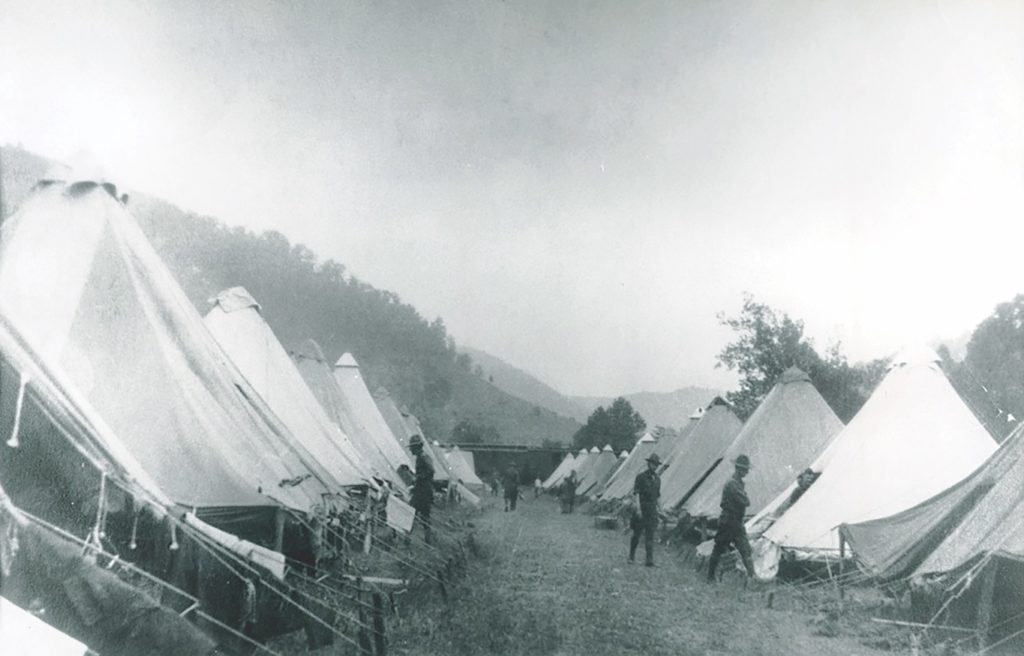
The miners advanced in two wings, aiming to scale the twin peaks of Blair Mountain from both north and south. The northern wing, anchored at Jeffrey, eight miles northeast of Blair Mountain, followed Hewitt Creek to Baldwin Fork, advancing south to Crooked Creek Gap. The defenders, commanded by Ivan Hollingsworth, a former captain in the American Expeditionary Forces in World War I, were backed by two machine guns, while the attackers fielded the Gatling gun they had seized. When one of the defenders’ machine guns jammed after overheating, the miners broke through the lines at Craddock Fork and headed directly for enemy headquarters at Logan. Hollingsworth, putting his wartime experience to good use, pulled back his men half a mile and threw up new breastworks, supported by the remaining machine gun. A reporter observed a group of 50 miners charge straight ahead before being driven back by machine-gun fire, carrying five of their wounded with them.
The defensive line held, but near-panic gripped Chafin’s headquarters at Logan. Walter R. Thurmond, the president of the Logan Coal Operators Association, breathlessly wired Republican Wells Goodykoontz, who represented the region in the U.S. House of Representatives: “Unless troops sent by midnight tonight, the town of Logan will be attacked by an army of from four to eight thousand reds and great loss of life and property sustained.” Goodykoontz passed along the warning to President Harding, adding, “Your proclamation is being contemptuously ignored.” Harding, who was enjoying a three-day Labor Day weekend cruise with his wife aboard the presidential yacht Mayflower, left matters up to General Bandholtz and Governor Morgan. In the meantime, Chafin sent his three borrowed biplanes to drop homemade pipe bombs and tear gas on miners’ positions near the towns of Blair and Bald Knob. The bombs fell wide of their targets, creating a few smoking craters but no injuries. Another bomb, luckily a dud, landed near two women washing clothes at Jeffery.
Bandholtz, who had used Mitchell’s own planes to scout the two opposing forces but denied the airman permission to bomb the miners, could see no end in sight. On September 2 he ordered in 2,100 U.S. Army reinforcements from the crack 19th, 26th, and 40th Infantry Regiments. Before the government troops could reach the front, the miners launched one last assault on Blair Mountain, attempting to outflank the defenders. It was useless. “We couldn’t fire a shot but what they would rake our line from top to bottom,” one of the miners told reporters. The defenders, he said, outshot them 100 to 1.
The next day the soldiers began arriving by train at the front. The 19th Infantry reached Madison, the de facto headquarters of the miners, while the 40th moved into position behind the defensive forces at Logan. The miners had fought mine guards, state police, and private militia, but they were not going to fight the U.S. Army. Blizzard ordered his men to stand down. The Battle of Blair Mountain was over. Associated Press reporter Boyden Sparkes, accompanying the soldiers, observed scores of miners heading away from the front, “a swarm of stubbly faced men getting out of the hills and back to their homes as fast and as quickly as flivvers could take them.” Sparkes became one of the last casualties of the battle when he was shot in the leg and creased in the scalp by fire from state policemen on the summit of the mountain. “We believe in shooting first and challenging afterward,” an unrepentant policeman told the journalist, who was not badly hurt in the incident.
Although an estimated 1 million rounds were fired in the Battle of Blair Mountain, casualties were remarkably low. An exact figure was never determined; neither side presented a tally. Estimates of the death toll ranged from 20 to more than 100, although local tradition maintains that the miners carried off dozens of their own casualties. “All estimates must remain elastic,” Blizzard said. “It was that kind of battle. Eyewitnesses who were not participants were not welcome.” Recent archaeological work has revealed that the miners, far from being a disorganized mob, had at one point established a textbook command center, rear guard, and perimeter.
After surrendering, the miners, especially those who had volunteered to fight in World War I, expected to be treated fairly. The army, however, served a president who stood firmly on the side of the mine owners. The miners were ordered to surrender their weapons; Chafin’s forces were allowed to simply walk away. The army soon departed as well, leaving justice in the hands of a hostile state government. Vindictive to a fault, Morgan ordered wholesale arrests, with state courts bringing more than 1,000 indictments for treason and murder against 500 miners. By contrast, not a single charge was brought against Chafin or any of his 3,000 men. But the charges against the miners were difficult to prove, and most of them, including Keeney, Mooney, and Blizzard, ultimately walked out of the courthouse as free men. Some West Virginia judges and juries, at least, were fair. Reverend John Wilburn and his son, however, were convicted of murder in Gore’s death and sentenced to 11 years in the state penitentiary. They were paroled after serving three years.
In many ways the Battle of Blair Mountain was a disaster for the miners. They had failed to free their comrades, end martial law, or bring the union to Mingo County. Chafin, by contrast, had kept his promise—“They shall not pass”—and he was lauded as a hero by coal operators and local townsfolk. The law remained firmly in the hands of the governor, the police, and the courts, and no one would ever face judgment for the cold-blooded murders of Sid Hatfield and Ed Chambers or for the many other atrocities visited on the miners and their families.
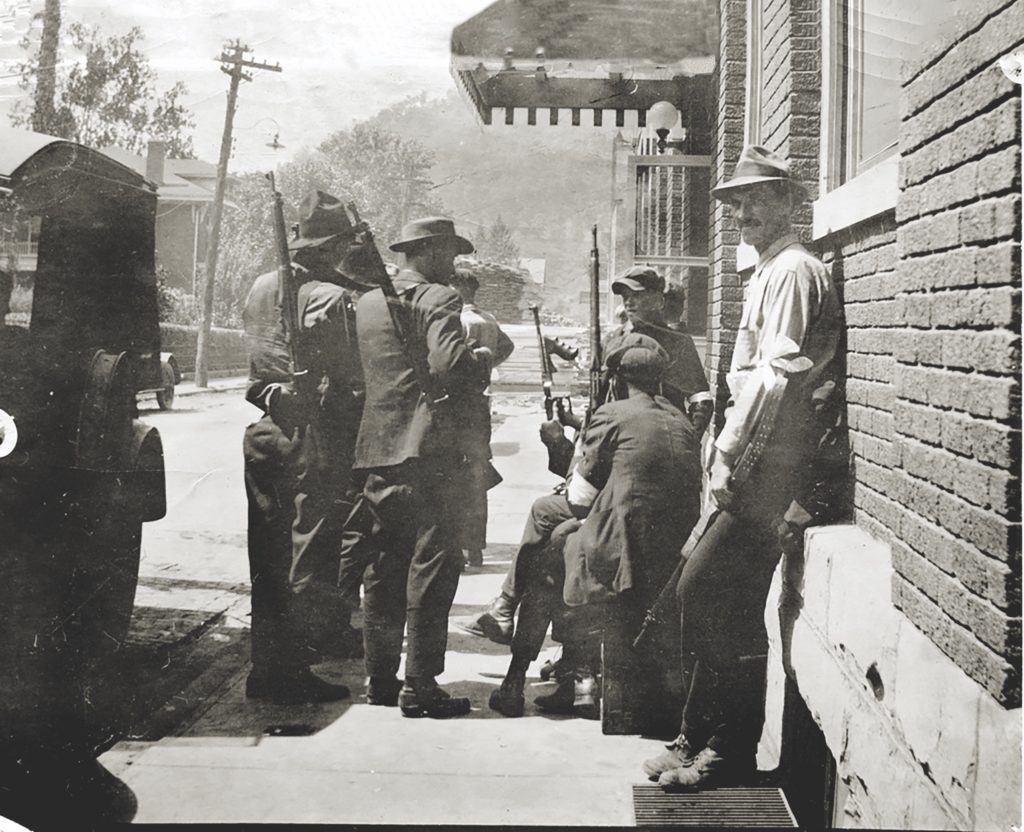
Nevertheless, the Battle of Blair Mountain represented an important step in the long crusade by miners to reclaim the civil liberties vouchsafed for all American citizens by the Constitution. As Charles Keeney, a great grandson of Frank Keeney, observed, the fight had been “an attempt to achieve economic justice for the working class.” In the mid-1930s, with Franklin D. Roosevelt in the White House, Congress passed legislation ensuring the basic rights for which the miners had fought and died at Blair Mountain. These included the right to unionize and bans on blacklisting and the hiring of private police. The coal companies had won the battle but lost the war.
In recent years, a new headstone has been erected over the grave of Sid Hatfield across the river from Matewan. Engraved on it are the words “Defender of the rights of working people, gunned down by Felts detectives on the steps of the McDowell County Courthouse in Welch, W. Va., during the great mine wars. His murder triggered the miners’ rebellion at the Battle of Blair Mountain. We will never forget.” It was, no doubt, the sort of epitaph Hatfield would have wanted.
Ron Soodalter is the author of Hanging Captain Gordon: The Life and Trial of an American Slave Trader (Atria Books, 2006).

this article first appeared in military history quarterly
Facebook: @MHQmag | Twitter: @MHQMagazine

